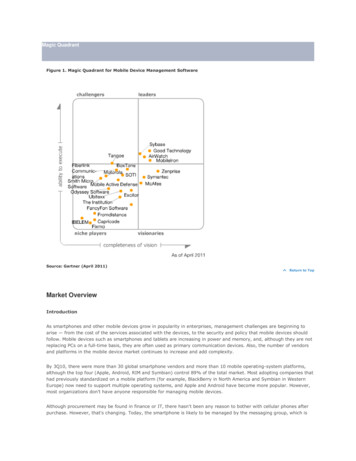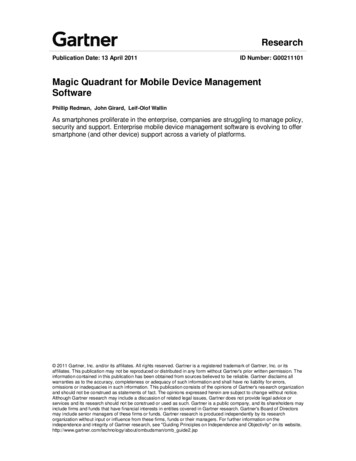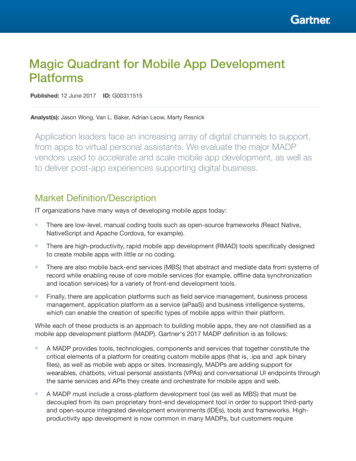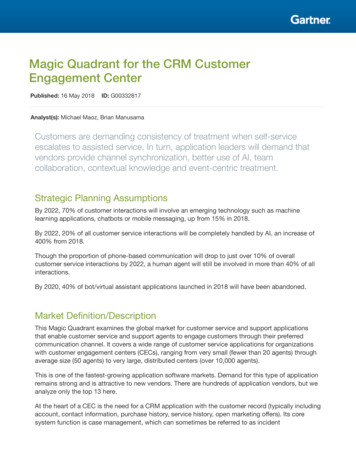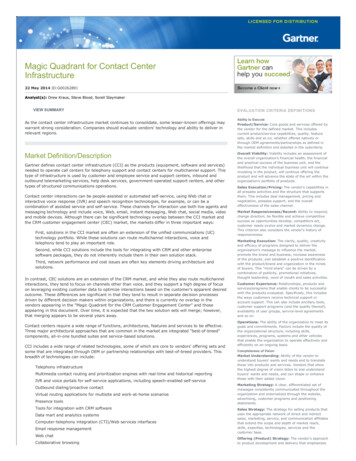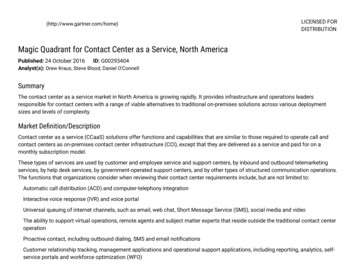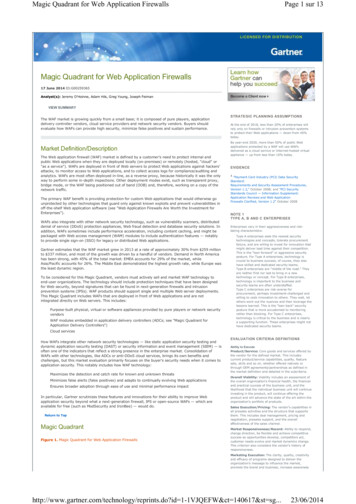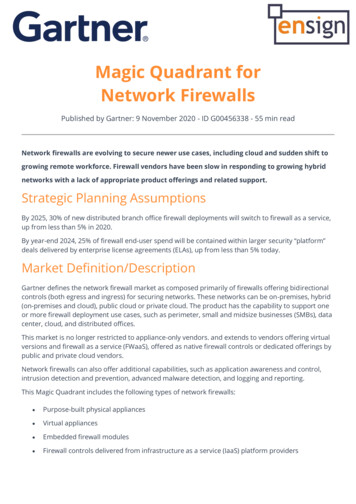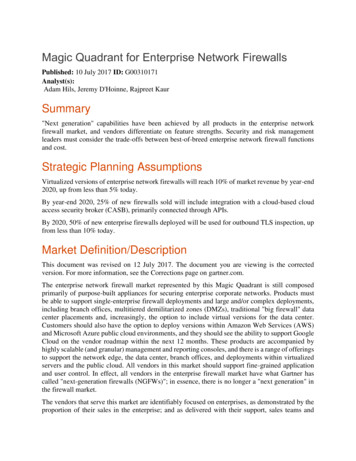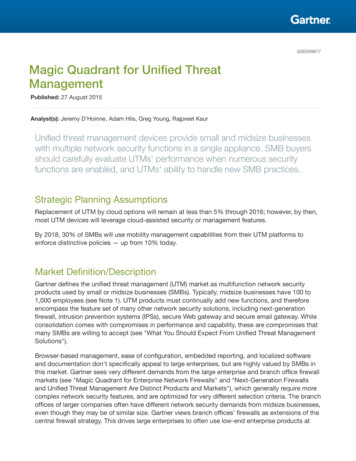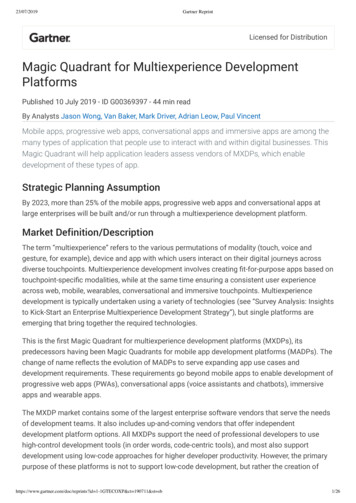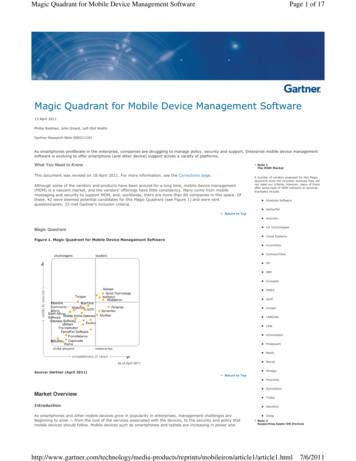
Transcription
Magic Quadrant for Mobile Device Management SoftwarePage 1 of 17Magic Quadrant for Mobile Device Management Software13 April 2011Phillip Redman, John Girard, Leif-Olof WallinGartner Research Note G00211101As smartphones proliferate in the enterprise, companies are struggling to manage policy, security and support. Enterprise mobile device managementsoftware is evolving to offer smartphone (and other device) support across a variety of platforms.What You Need to KnowNote 1The MDM MarketThis document was revised on 18 April 2011. For more information, see the Corrections page.Although some of the vendors and products have been around for a long time, mobile device management(MDM) is a nascent market, and the vendors' offerings have little consistency. Many come from mobilemessaging and security to support MDM, and, worldwide, there are more than 60 companies in this space. Ofthese, 42 were deemed potential candidates for this Magic Quadrant (see Figure 1) and were sentquestionnaires; 23 met Gartner's inclusion criteria.A number of vendors assessed for this MagicQuadrant were not included, because they didnot meet our criteria; however, many of themoffer some type of MDM software or services.Examples include: Absolute Software AetherPalReturn to Top Avoceen CA TechnologiesMagic Quadrant Cloud SystemsFigure 1. Magic Quadrant for Mobile Device Management Software CommSolv CommonTime HP IBM Innopath iPASS Jamf Juniper LANDesk LRW mFormation Mobiquant Notify Novell PerlegoSource: Gartner (April 2011)Return to Top Proximity SynchPointMarket OverviewIntroductionAs smartphones and other mobile devices grow in popularity in enterprises, management challenges arebeginning to arise — from the cost of the services associated with the devices, to the security and policy thatmobile devices should follow. Mobile devices such as smartphones and tablets are increasing in power and Trellia Wavelink ZelogNote 2Supporting Apple iOS 6/2011
Magic Quadrant for Mobile Device Management Softwarememory, and, although they are not replacing PCs on a full-time basis, they are often used as primarycommunication devices. Also, the number of vendors and platforms in the mobile device market continues toincrease and add complexity.By 3Q10, there were more than 30 global smartphone vendors and more than 10 mobile operating-systemplatforms, although the top four (Apple, Android, RIM and Symbian) control 89% of the total market. Mostadopting companies that had previously standardized on a mobile platform (for example, BlackBerry in NorthAmerica and Symbian in Western Europe) now need to support multiple operating systems, and Apple andAndroid have become more popular. However, most organizations don't have anyone responsible for managingmobile devices.Although procurement may be found in finance or IT, there hasn't been any reason to bother with cellularphones after purchase. However, that's changing. Today, the smartphone is likely to be managed by themessaging group, which is responsible for the BlackBerry Exchange Server (BES), rather than by the entityresponsible for managing computing hardware. Although many companies may have device managementresponsibilities, usually for hardware such as PCs or phones, current software doesn't really cover mobiledevices, nor is IT staff trained to support handheld devices.Elements of MDMAlthough many companies are trying to solve a similar problem, it takes multiple types of mobile software toaddress a full solution. A fully managed mobility solution cuts across standard MDM and telecom expensemanagement and includes:Page 2 of 17Questions about support for Apple iOS devicescontinues to grow. Apple controls much of howapplications are developed and supported inthe enterprise, with no exceptions. AlthoughApple has increased its enterprise capability, itstill has the strictest requirements forenterprise application support. To use MDMcapabilities built into iOS 4, your organizationmust enroll in the iOS Developer EnterpriseProgram (iDEP). Once accepted, anorganization will receive an Apple PushNotification Service (APNS) certificate, which itcan load into an MDM platform. This will allowan organization to create, sign and host itsown iOS applications, without having to gothrough the iTunes store. If you are onlyimplementing Simple Certificate EnrollmentProtocol (SCEP), then iDEP is not required. AnMDM platform is needed to supportapplications on an iPhone or iPad. Applepublishes a list of its major partners; however,other vendors may also support iOS devices.All MDM providers use the same method formanaging iOS devices, an XML documentcalled the configuration profile, which Appledefines. Because of this, all MDM providers willprovide similar features. There are limits,imposed by Apple, to the configuration profilebased management versus other operatingsystem platforms, which may include: Software Distribution — The ability to manage and support mobile application including deploy, install,update, delete or block. Apple has removed the APIs to detectjailbroken phones. Policy Management — Development, control and operations of enterprise mobile policy. The root configuration profile can beremoved by the user. Inventory Management — Beyond basic inventory management, this includes provisioning andsupport. Applications cannot be pushed orpulled onto the device by ITadministrators. Security Management — The enforcement of standard device security, authentication and encryption. Device may be erased using iTunesand use iTunes for backup. Service Management — Rating of telecom services.Conclusion Over-the-air operating-system updatesare not supported — these need to bedone in iTunes.Vendors Added or DroppedThe MDM market is quickly evolving. The requirements and definitions are changing rapidly, and vendorofferings will evolve quickly and be even more capable and mature by next year. High demand is creating afrenzy of development, as well as hope. Although many of the successful MDM providers have focused almostexclusively on mobility, during the next few years, those managing PCs will also be investing and looking foropportunities in the MDM space. Most vendors now offer on-premises or software-as-a-service (SaaS)-basedtools, and more-mature managed service offerings will emerge during the next three years to drive growth inthe industry.Some key things to keep in mind when assessing an MDM vendor are: Some of the device platforms will limit manageability, due to inherent manufacturer design — don'texpect MDM solutions to address each platform the same way or support it the same way. Android support is still immature — it will be another year before Android is well-supported by most MDMvendors. BlackBerry support is still important — not all MDM vendors support BES integration. It is important thatBlackBerry support continues, because, in many regions, it is still the most-supported enterprise device,even as other platforms take away market share. MDM tools won't beat the BES, but should be able tohelp manage and report on BlackBerry devices. Don't underestimate reporting — for some vendors, their reporting and business intelligence (BI) toolsare simple if they have them at all. Reporting on device status will be a critical component, and vendor capability to offer both text andgraphical reports, canned and customized, is critical.With the advent of new devices, the MDM market is growing quickly. If we assess pure MDM revenue (excludingrevenue for messaging, security, etc.) year-end 2010 is estimated at 150 million, increasing at a compoundannual growth rate (CAGR) of 15% to 20% during the next three years.Market Definition/DescriptionEnterprise MDM products and services help enterprises manage the transition to a more complex, mobilecomputing and communications environment by supporting security, service, software and inventorymanagement across multiple operating-system platforms, primarily for handheld devices such as smartphonesand tablets. To meet Gartner's definition, MDM vendors must address at least three of the four "elements ofMDM" set forth in the market overview and support MDM capabilities or features in mobile applicationplatforms, with an emphasis on MDM. Rated vendors are generally expected to be able to respondcompetitively with respect to the following features and functions.Inclusion and Exclusion CriteriaWe review and adjust our inclusion criteria forMagic Quadrants and MarketScopes as marketschange. As a result of these adjustments, themix of vendors in any Magic Quadrant orMarketScope may change over time. A vendorappearing in a Magic Quadrant or MarketScopeone year and not the next does not necessarilyindicate that we have changed our opinion ofthat vendor. This may be a reflection of achange in the market and, therefore, changedevaluation criteria, or a change of focus by avendor.Evaluation Criteria DefinitionsAbility to ExecuteProduct/Service: Core goods and servicesoffered by the vendor that compete in/servethe defined market. This includes currentproduct/service capabilities, quality, featuresets and skills, whether offered natively orthrough OEM agreements/partnerships asdefined in the market definition and detailed inthe subcriteria.Overall Viability (Business Unit, Financial,Strategy, Organization): Viability includesan assessment of the overall organization'sfinancial health, the financial and practicalsuccess of the business unit, and the likelihoodthat the individual business unit will continueinvesting in the product, will continue offeringthe product and will advance the state of theart within the organization's portfolio ofproducts.Sales Execution/Pricing: The vendor’scapabilities in all pre-sales activities and thestructure that supports them. This includesdeal management, pricing and negotiation,pre-sales support and the overall effectivenessof the sales channel.Market Responsiveness and Track Record:Ability to respond, change direction, be flexibleand achieve competitive success asopportunities develop, competitors act,customer needs evolve and market dynamicschange. This criterion also considers thevendor's history of responsiveness.Marketing Execution: The clarity, quality,creativity and efficacy of programs designed 1
Magic Quadrant for Mobile Device Management SoftwareGartner is aware of more than 60 vendors that claim some level of play in MDM on a global basis. In mostmarkets, even growth markets, large numbers of competing vendors with similar products are cause forconcern and indicate a need for competitive natural selection and consolidation.Inclusion CriteriaAfter due consideration, 23 vendors were selected to be included for ranking in this Magic Quadrant. Thefollowing criteria are necessary for inclusion: Support for enterprise-class (noncarrier), multiplatform support MDM: software or SaaS, with anemphasis on mobility Specific MDM product focus and feature set or a primary focus on MDM in another product set(messaging or security) Security management, with at least these features: Enforced password Device wipe Remote lock Audit trail/logging "Jailbreak" detection At least mobile OS 3 platforms supported Policy/compliance management Software distribution, with at least these capabilities supported: Application downloader Application verification Application update support Application patch supportInventory management, with at least these capabilities supported: External memory blocking Configuration change history Managing at least 25,000 mobile lines Five referenceable accounts At least 1 million in MDM-specific revenueExclusion CriteriaMDM companies not included in this Magic Quadrant might have been excluded for one or more of theseconditions: The company did not have a competitive product on the market for a sufficient amount of time duringcalendar year 2010 and the first quarter of 2011 to establish a visible, competitive position and trackrecord. The company had a minimal apparent market share and low market inquiry interest among Gartnerclients. The company was invited to participate, but did not reply to an annual request for information and didnot otherwise meet the inclusion criteria. Alternative means of assessment, particularly client requestsand competitive visibility, did not meet the inclusion criteria.Page 3 of 17deliver the organization's message to influencethe market, promote the brand and business,increase awareness of the products, andestablish a positive identification with theproduct/brand and organization in the minds ofbuyers. This "mind share" can be driven by acombination of publicity, promotionalinitiatives, thought leadership, word-of-mouthand sales activities.Customer Experience: Relationships,products and services/programs that enableclients to be successful with the productsevaluated. Specifically, this includes the wayscustomers receive technical support or accountsupport. This can also include ancillary tools,customer support programs (and the qualitythereof), availability of user groups, servicelevel agreements and so on.Operations: The ability of the organization tomeet its goals and commitments. Factorsinclude the quality of the organizationalstructure, including skills, experiences,programs, systems and other vehicles thatenable the organization to operate effectivelyand efficiently on an ongoing basis.Completeness of VisionMarket Understanding: Ability of the vendorto understand buyers' wants and needs and totranslate those into products and services.Vendors that show the highest degree of visionlisten to and understand buyers' wants andneeds, and can shape or enhance those withtheir added vision.Marketing Strategy: A clear, differentiatedset of messages consistently communicatedthroughout the organization and
Magic Quadrant for Mobile Device Management Software 13 April 2011 Phillip Redman, John Girard, Leif-Olof Wallin Gartner Research Note G00211101 As smartphones proliferate in the enterprise, companies are struggling to manage policy, security and support. Enterprise mobile device management
